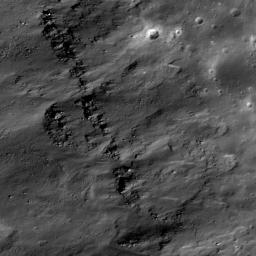
|
Lichtenberg Crater
- Click the image above for a larger view
- Full-Res JPEG (1000 x 1000) (133.4 kB)
- Full-Res TIFF (1000 x 1000) (1.0 MB)
Caption:
Lichtenberg crater is of Eratosthenian age, 20 kilometers (12 miles) across and 1.2 kilometers (1312 yards) deep, located in western Oceanus Procellarum (31.8°N and 67.7°W). It is named after George C. Lichtenberg, a German professor of experimental physics (16th century). Lichtenberg has an extensive ejecta blanket with highly reflective rays which extend to the North more than 100 kilometers from the crater rim. Within the detailed image shown above, distinct layering inside the crater wall can be seen. These layers are probably outcrops of the original surface lavas which were deposited before impact event. NAC frame M112040133L; scene is 530 meters (1738 feet) across.
Background Info:
NASA's Goddard Space Flight Center built and manages the mission for the Exploration Systems Mission Directorate at NASA Headquarters in Washington. The Lunar Reconnaissance Orbiter Camera was designed to acquire data for landing site certification and to conduct polar illumination studies and global mapping. Operated by Arizona State University, LROC consists of a pair of narrow-angle cameras (NAC) and a single wide-angle camera (WAC). The mission is expected to return over 70 terabytes of image data.
Cataloging Keywords:
| Name | Value | Additional Values |
|---|---|---|
| Target | Moon | |
| System | Earth | |
| Target Type | Satellite | |
| Mission | Lunar Reconnaissance Orbiter (LRO) | |
| Instrument Host | Lunar Reconnaissance Orbiter | |
| Host Type | Orbiter | |
| Instrument | Lunar Reconnaissance Orbiter Camera (NAC) | |
| Detector | Narrow Angle Camera (NAC), Wide Angle Camera (WAC) | |
| Extra Keywords | Crater, Grayscale, Impact | |
| Acquisition Date | ||
| Release Date | 2010-06-15 | |
| Date in Caption | ||
| Image Credit | NASA/GSFC/Arizona State University | |
| Source | photojournal.jpl.nasa.gov/catalog/PIA13223 | |
| Identifier | PIA13223 | |
